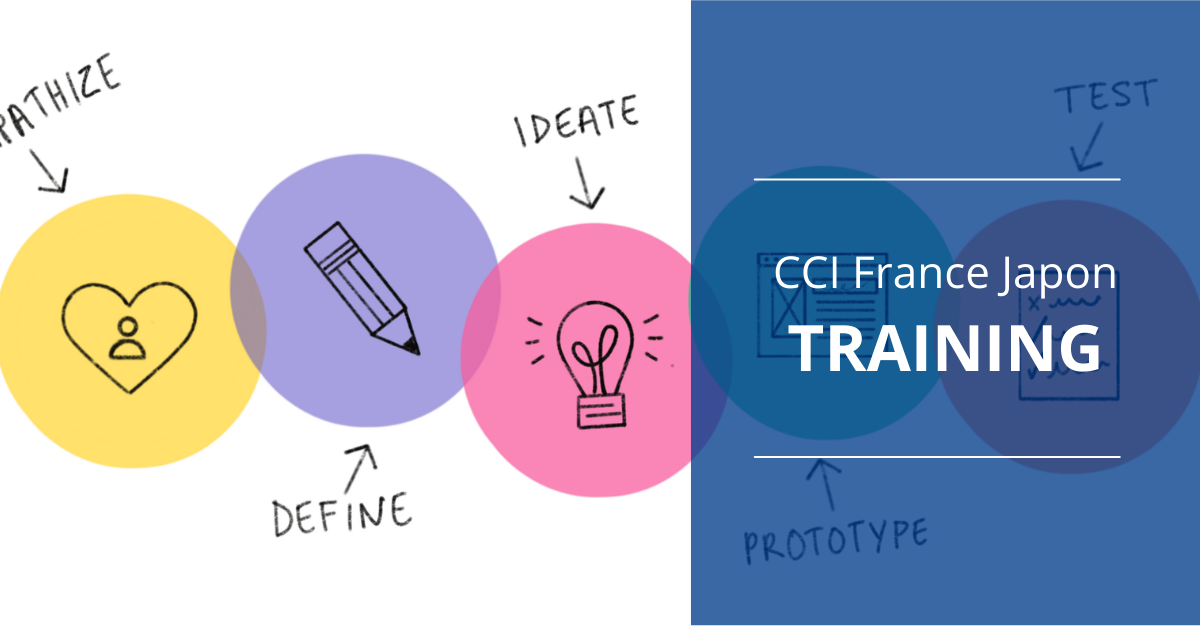
Formation
Training - Design Thinking (English)
Langue(s) de l'événement
English
Tarif :
Member price : 90 000 JPY
Non member price : 100 000 JPY
Tax excluded
L'événement est terminé.

The French Chamber is organizing a Design Thinking Training throughout two days.
Innovation and Transformation are the foundation of designing our digital working world. Design Thinking tackles unknown problems by reframing these in human-centric ways. Of all design processes, design thinking is almost certainly the best for “thinking outside the box”.
WHO SHOULD ATTEND?
This training is designed for those seeking to deepen their knowledge on Design Thinking, by re-thinking about the user, challenge assumptions, and redefine problems in an attempt to identify alternative strategies and solutions. Additionally, it is oriented towards those seeking a solution-based approach to solving problems.
Teams are welcome and highly recommended to benefit the training to its fullest.
OBJECTIVES
5 Business Cases of Design Thinking:
- Ignite new business opportunities | by engaging people from different disciplines, we gain deeper insights that when cross-pollinated, created unseen competitive advantages.
- Efficient Operations | by operating in an iterative way, we save precious resources; people, time and money. We go for improvement through customer data, not internal preparation.
- Gain future investment faster | by deeply understanding user and project needs we efficiently allocate resources, go to market quicker and earn income required for innovation in a shorter time frame.
- Deeper customer relationships | co-creating new solutions with clients develops trust and a closer ‘partner’ working relationship. Resulting in long-term customer relationships.
- Organizational culture change | Attract, hire and retain world class talent. Build a creative organization where innovation can thrive as individuals play to their strengths.
TRAINING PROGRAM
- Empathize - Developing empathy for the user
Gain an empathetic understanding of the problem to be solved. Empathy is crucial to a human-centered design process such as design thinking: here, you set aside your own assumptions about the world and gain real insight into users and their needs.
- Define - Reframe Challenge (HMW)
Accumulate the information gathered during the first stage. Analyze your observations and synthesize them to define the core problems you and your team have identified.
- Ideation - Creativity & Structure
Generate ideas. The solid background of knowledge from the first two phases means you can start to “think outside the box”, look for alternative ways to view the problem and identify innovative solutions to the problem statement you’ve created. Brainstorming is particularly useful here.
- Prototype - Build to get feedback
This is an experimental phase. The aim is to identify the best possible solution for each problem found. Your team should produce some inexpensive, scaled-down versions of the product (or specific features found within the product) to investigate the ideas you’ve generated. This could involve simply paper prototyping.
- Test - Show and “Shut Up”
Evaluators rigorously test the prototypes. Although this is the final phase, design thinking repeats itself: Teams often use the results to redefine one or more further problems. So, you can return to previous stages to make further iterations, alterations and refinements – to find or rule out alternative solutions.
About the partner
Design Thinking Japan
Design Thinking Japan has been a trusted partner in the North and South America, Asia and Europe to 60+ brands, since 2014. They designed, coordinated and facilitated more than 168 workshops in English, German, Spanish and Japanese. More than 3120 people participated in their sessions. While, we believe in building capability, they also believe building community is equally important.
Training - Design Thinking (English)
L'événement est terminé.